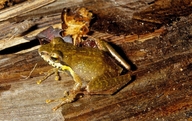|
Description
A member of the Mantidactylus boulengeri-group, which contains M. boulengeri, M. boulengeri "leucocephalus", M. decaryi, M. eiselti, M. thelenae, M. klemmeri and M. webbi. This group is composed of rather small species (20-35 mm). Lateral metatarsalia are connected. An outer metatarsal tubercle is present, with the exception ofM. webbi. Webbing is absent between the fingers and reduced between the toes, except for M. webbi, in which the feet are moderately webbed. Nostrils are situated nearer to the tip of the snout than the eye. Males have paired subgular vocals sacs which are white in M. webbi and dark in the other species. Femoral glands are distinct in males, absent in females. These frogs are active and call mainly during the day. M. webbi and M. klemmeri live on mossy stones along brooks; calling males of the other species do not aggregate around water. Direct development has been observed in M. eiselti. On the lip, alternating light and dark transverse bands are present, as in the subgenus Brygoomantis, whose species are also mainly terrestrial with at least partial diurnal activity. Representatives can be distinguished from most other Mantidactylus by the paired subgular vocal sacs of males, only also present in the M. granulatus-group, which is composed of larger and mainly nocturnal species.
Mantidactylus eiselti (GUIBÉ 1975) is a small brownish species of Mantidactylus, males 20-23 mm. Dorsum more or less uniformly light brown. Lips with alternating yellow and brown transverse bands. Ventral surface with dark punctations. Hind legs with bands. Skin more or less smooth. Tympanum distinct, minimum about 2/5 of eye diameter. Tibiotarsal articulation reaches the nostril. Lateral metatarsalia connected. Webbing reduced. Males with a subgular vocal sac, which appears to be paired when not inflated because of the two blackish lateral skin folds on the throat. However the inflated sac is clearly single subgular as was also observed in M. thelenae. Males with oblong but rather indistinct femoral glands, not recognizable in preserved material.
Similar species: M. thelenae is the most similar species. M. boulengeri from Andasibe is similar in appearance, but its skin is usually more granular. Males can easily be distinguished by call and colouration. In M. decaryi, the tibiotarsal articulation reaches beyond the tip of snout. M. klemmeri differs in appearance and by its smaller tympanum. M. pseudoasper is larger.
Distribution and Habitat
Country distribution from AmphibiaWeb's database: Madagascar
Analamazaotra, Andasibe, Ankeniheny, Mantadia, Vohidrazana. It occurs between 800-1,200m asl in secondary and degraded forest, and low secondary vegetation, but only rarely in primary forest (Vallan and Glaw 2008).Life History, Abundance, Activity, and Special Behaviors
Calling males were heard only during the day between December and February, not concentrated around water. They sit in vegetation about 20-50 cm above the ground in primary forest, or (even more commonly) in secondary bush vegetation. Often aggregations of calling males can be found in secondary fern vegetation. In choruses alternating calls were heard. The shortest observed distance between two calling males was about 2 m.
Call (from the terra typica, ca. 23 °C): The call is a series of about 7-24 (mean 21, n=14) harmonic notes. Note duration is about 180 ms, interval duration is 300-370 ms, note repetition rate 2.3/s and frequency about 4 kHz. A whole call can continue for about 10 s, the interval between two calls a few minutes.
Eggs and tadpoles (from the terra typica): Direct development. A clutch of four eggs was found at February, 28th, in wet and dead leaves of fern vegetation, when searching for calling males, which were abundant at this locality. Egg diameter including the jelly was 10 mm; the eggs were already in the neurula stage. The further development of the embryos was observed by Martina Thelen at Antananarivo: At 16. March, the hindlegs are well developed and tadpoles move in the jelly. At 20. March, forelegs begin to develop; the embryos are very active in the jelly. 23. March: after a slight tactile stimulus one froglet emerges from the jelly. 24. March: Both froglets have hatched, still with a remain of tail. 25. March: Tail has completely disappeared. SVL of the froglets is 6 mm.
Breeding takes place directly away from water (Vallan and Glaw 2008). Trends and Threats
It occurs in Parc National de Mantadia and the Réserve Spéciale d’Analamazaotra (Vallan and Glaw 2008). Comments
Taken with permission from Glaw and Vences (2007).
References
Glaw, F., and Vences, M. (2007). Field Guide to the Amphibians and Reptiles of Madagascar. Third Edition. Vences and Glaw Verlag, Köln.
Vallan, D. and Glaw, F. (2008). Gephyromantis eiselti. In: IUCN 2008. 2008 IUCN Red List of Threatened Species. www.iucnredlist.org. Downloaded on 14 April 2009.
Originally submitted by: Miguel Vences and Frank Glaw (first posted 2000-11-27)
Edited by: Henry Zhu (2009-05-06)Species Account Citation: AmphibiaWeb 2009 Gephyromantis eiselti <https://amphibiaweb.org/species/4594> University of California, Berkeley, CA, USA. Accessed Jun 15, 2025.
Feedback or comments about this page.
Citation: AmphibiaWeb. 2025. <https://amphibiaweb.org> University of California, Berkeley, CA, USA. Accessed 15 Jun 2025.
AmphibiaWeb's policy on data use.
|
